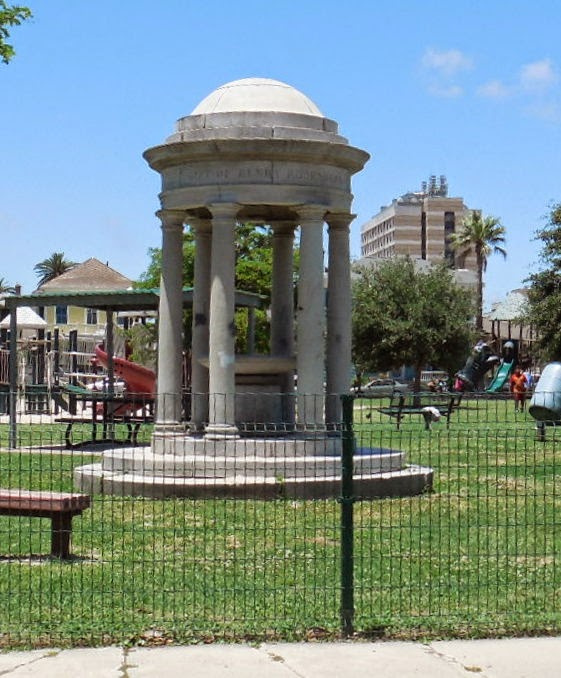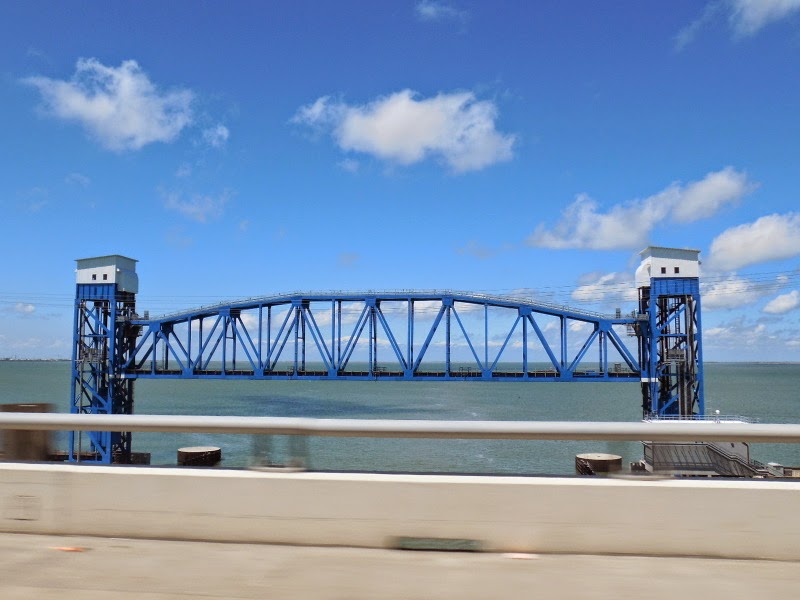5. Galveston, June,
2014
Galveston has had quite a history with hurricanes. There
have been many hurricanes that have come over this island but the two that we
heard most about are the Hurricane of 1900 and Hurricane Ike in 2008.
Our first atop was at the Visitors Center. There are always
very knowledgeable people eager to give you the information you need to see the
sights that interest you. They supplied us with a city map and handfuls of
brochures. 
After getting our bearings we drove along Seawall Blvd. This
area along the seawall is the highest part of Galveston Island. Fill was
brought in and the seawall built after the Hurricane of 1900 to protect from
storm surges. The island slopes downward from the seawall to the bay.
Before I get too far along I should spend a bit of time on The Hurricane of 1900 and Hurricane Ike:
The
Hurricane of 1900
From Wikipedia, the
free encyclopedia
The hurricane caused great loss of life with the
estimated death toll between 6,000 and 12,000 individuals;[3] the number most cited in official
reports is 8,000, giving the storm the third-highest number of deaths or
injuries of any Atlantic
hurricane,
after the Great
Hurricane of 1780 and 1998's Hurricane Mitch. The Galveston Hurricane of 1900 is the
deadliest natural disaster ever to strike the
United States. By contrast, the second-deadliest storm to strike the United
States, the 1928
Okeechobee hurricane, caused more than 2,500 deaths, and
the deadliest storm of recent times, Hurricane Katrina, claimed the lives of
approximately 1,800 people.”
Here are a couple of pictures from
Wikipedia:

Hurricane Ike
Excerpts from Wikipedia:
“In Galveston, by 4 p.m. CDT (2100 UTC) on September 12, the rising storm surge began overtopping the 17-ft (5.2 m)Galveston Seawall, which faces the Gulf of Mexico;[29] waves had been crashing along the seawall earlier, from 9 a.m. CDT.[38] Although Seawall Boulevard is elevated above the shoreline, many areas of town slope down behind the seawall to the lower elevation of Galveston Island.”
“None of the many wooden piers that gave Galveston much of its unique character survived the landfall of Hurricane Ike”.
“The seemingly protected back side of the island also suffered heavy damage to tourist areas.”
Here is a picture depicting water levels from various storms. As you can see the water level from Ike was much deeper than any of the other hurricanes.”
---------------------------------------
Since the island sloped from the seawall to the bay, after Ike’s surge went over the seawall the resulting water level were lowest at the wall and was highest at the bay side (residential and business districts). In the picture below the lowest water level mark belongs to Hurricane Carla, 1962, next highest is the Storm (Hurricane) of 1900, third highest is the Storm of 1915 and the highest belongs to Hurricane Ike in 2008.
Along the road by the seawall:
We found our way to a place called “Nicks” for lunch. It had
a couple of displays typical of seafood restaurants.
After lunch we went on a tour. The vehicle was an electric
powered care that could hold up to eight although there were only four of us
for this tour. The tour took us through the historic district where there are
many home the survived the Hurricane of 1900. There is a little plaque that is
attached to these houses along with another plaque that designates the water
level of various storms. Here is an example.
There is a Historic District where some homes predate the
Hurricane of 1900. Here are some of the old homes and buildings.

This next (left, below) one is waiting for restoration. The one on the right, below is across the street from where the historical district ends. So, it could have been torn down. In order to prevent that, the Historical Society bought the house and did repairs and painting it is now for sale and the society will used the profits for other restoration projects.

Galveston has tree sculptures made from the stumps of trees destroyed by Hurricane Ike. There were hundreds of tons of wood from the trees that were destroyed by the storm. People wanted to make sure this wood did not end up in landfills. More than 100 tons were used in the restoration of America’s only whaling ship. Another 200 tons went to Span to build a replica of the brig “Galveztown”. Sever
Galveston has tree sculptures made from the stumps of trees
destroyed by Hurricane Ike. There were hundreds of tons of wood from the trees
that were destroyed by the storm. People wanted to make sure this wood did not
end up in landfills. More than 100 tons were used in the restoration of
America’s only whaling ship. Another 200 tons went to Span to build a replica
of the brig “Galveztown”. Several tons were used in building projects. There are three men, Earl Jones, Dale Lewis
and Jim Phillips that did the carvings (for a fee, paid by the home owner).
There was one man that did not want to pay and decided he would do his own
sculpture. Here is his guitar along with some of the others.
al tons were used in building projects. There are three men, Earl Jones, Dale Lewis
and Jim Phillips that did the carvings (for a fee, paid by the home owner).
There was one man that did not want to pay and decided he would do his own
sculpture. Here is his guitar along with some of the others.
There are a variety of birds on this stump.



As we were riding along we can past a reflective storefront. Sooooooo. Here we are!
We passed an old building that still had an advertisement from a long time ago. A couple of famous mansions, the Moody Mansion and the Bishops house. You can tour 20 rooms of the Moody Mansion. Th3 bishop’s place was built by Colonel Walter Gresham, a lawyer and today is owned by the Galveston-Houston Catholic Archdiocese. It is a museum and can be toured.


A Swiss business and philanthropist, Henry Rosenberg, left his fortune to the city with a stipulation that the money be spent on things that would be free to the citizens (the library, YMCA, etc) AND he wanted fountains to supply water for thirsty people, horses, dogs and cats. There were 17 fountains built but today most no longer supply water and are considered art.
 www
www
There was the Train Museum and an oil rig museum. We drove passed but decided not to go in.

On the way back to the park Jackie got this picture of the railroad lift bridge that parallels the highway over Galveston Bay and then we were back on the mainland

There are more pictures on Shutterfly, some mine, some
Jackie’s. https://jackbarbic.shutterfly.com/7774
























No comments:
Post a Comment